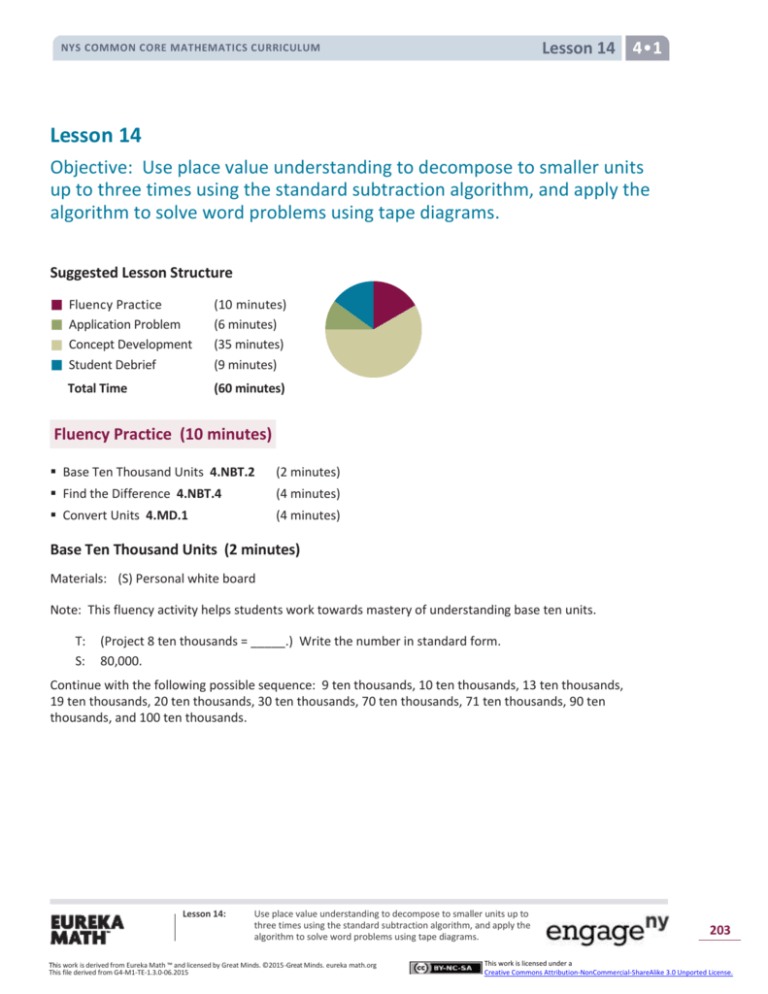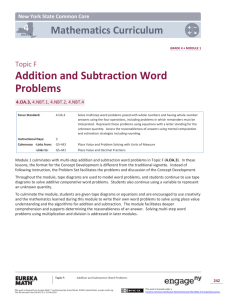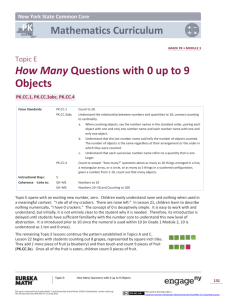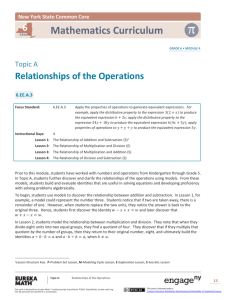Lesson 14 - EngageNY
advertisement

Lesson 14 NYS COMMON CORE MATHEMATICS CURRICULUM Lesson 14 Objective: Use place value understanding to decompose to smaller units up to three times using the standard subtraction algorithm, and apply the algorithm to solve word problems using tape diagrams. Suggested Lesson Structure Fluency Practice Application Problem Concept Development Student Debrief Total Time (10 minutes) (6 minutes) (35 minutes) (9 minutes) (60 minutes) Fluency Practice (10 minutes) Base Ten Thousand Units 4.NBT.2 (2 minutes) Find the Difference 4.NBT.4 (4 minutes) Convert Units 4.MD.1 (4 minutes) Base Ten Thousand Units (2 minutes) Materials: (S) Personal white board Note: This fluency activity helps students work towards mastery of understanding base ten units. T: S: (Project 8 ten thousands = _____.) Write the number in standard form. 80,000. Continue with the following possible sequence: 9 ten thousands, 10 ten thousands, 13 ten thousands, 19 ten thousands, 20 ten thousands, 30 ten thousands, 70 ten thousands, 71 ten thousands, 90 ten thousands, and 100 ten thousands. Lesson 14: Use place value understanding to decompose to smaller units up to three times using the standard subtraction algorithm, and apply the algorithm to solve word problems using tape diagrams. This work is derived from Eureka Math ™ and licensed by Great Minds. ©2015 -Great Minds. eureka math.org This file derived from G4-M1-TE-1.3.0-06.2015 203 This work is licensed under a Creative Commons Attribution-NonCommercial-ShareAlike 3.0 Unported License. Lesson 14 NYS COMMON CORE MATHEMATICS CURRICULUM Find the Difference (4 minutes) Materials: (S) Personal white board Note: This math fluency activity prepares students for understanding the importance of the subtraction algorithm. T: S: (Write 735 – 203 =____.) Write a subtraction sentence horizontally or vertically. (Write 735 – 203 = 532.) Repeat process and sequence for 7,045 – 4,003; 845 – 18; 5,725 – 915; and 34,736 – 2,806. Convert Units (4 minutes) Note: Reviewing the relationship between meters and centimeters learned in Grade 3 helps prepare students to solve problems with metric measurement and to understand metric measurement’s relationship to place value. T: S: (Write 1 m = ___ cm.) How many centimeters are in a meter? 1 m = 100 cm. Repeat the process for 2 m, 3 m, 8 m, 8 m 50 cm, 7 m 50 cm, and 4 m 25 cm. T: S: T: S: (Write 100 cm = ___ m.) Say the answer. 100 cm = 1 m. (Write 150 cm = ___ m ___ cm.) Say the answer. 150 cm = 1 m 50 cm. Repeat the process for 250 cm, 350 cm, 950 cm, and 725 cm. Application Problem (6 minutes) In one year, the animal shelter bought 25,460 pounds of dog food. That amount was 10 times the amount of cat food purchased in the month of July. How much cat food was purchased in July? Extension: If the cats ate 1,462 pounds of the cat food, how much cat food was left? Extension: Note: This Application Problem incorporates prior knowledge of 10 times as many with the objective of decomposing to smaller units in order to subtract. Lesson 14: Use place value understanding to decompose to smaller units up to three times using the standard subtraction algorithm, and apply the algorithm to solve word problems using tape diagrams. This work is derived from Eureka Math ™ and licensed by Great Minds. ©2015 -Great Minds. eureka math.org This file derived from G4-M1-TE-1.3.0-06.2015 204 This work is licensed under a Creative Commons Attribution-NonCommercial-ShareAlike 3.0 Unported License. Lesson 14 NYS COMMON CORE MATHEMATICS CURRICULUM Concept Development (35 minutes) Materials: (S) Personal white board Problem 1: Subtract, decomposing twice. Write 22,397 – 3,745 vertically on the board. T: Let’s read this subtraction problem together. Watch as I draw a tape diagram labeling the whole, the known part, and the unknown part using a variable, A. Now, it is your turn. T: Record the problem on your personal white board. T: Look across the digits. Am I ready to subtract? S: No. T: We look across the top number to see if I have enough units in each column. Are there enough ones in the top number to subtract the ones in the bottom number? S: Yes, 7 ones is greater than 5 ones. T: Are there enough tens in the top number to subtract the tens in the bottom number? S: Yes, 9 tens is greater than 4 tens. T: Are there enough hundreds in the top number to subtract the hundreds in the bottom number? S: No, 3 hundreds is less than 7 hundreds. We can unbundle 1 thousand as 10 hundreds to make 1 thousand and 13 hundreds. I can subtract the hundreds column now. T: Watch as I record that. Now, it is your turn to record the change. T: Are there enough thousands in the top number to subtract the thousands in the bottom number? S: No, 1 thousand is less than 3 thousands. We can unbundle 1 ten thousand to 10 thousands to make 1 ten thousand and 11 thousands. I can subtract in the thousands column now. T: Watch as I record. Now, it is your turn to record the change. T: Are there enough ten thousands in the top number to subtract the ten thousands in the bottom number? S: Yes. T: Are we ready to subtract? S: Yes, we are ready to subtract. T: S: 7 ones minus 5 ones? 2 ones. (Record 2 in the ones column.) Continue subtracting across the problem, always naming the units. T: S: Say the equation with me. 22,397 minus 3,745 equals 18,652. Lesson 14: Use place value understanding to decompose to smaller units up to three times using the standard subtraction algorithm, and apply the algorithm to solve word problems using tape diagrams. This work is derived from Eureka Math ™ and licensed by Great Minds. ©2015 -Great Minds. eureka math.org This file derived from G4-M1-TE-1.3.0-06.2015 205 This work is licensed under a Creative Commons Attribution-NonCommercial-ShareAlike 3.0 Unported License. Lesson 14 NYS COMMON CORE MATHEMATICS CURRICULUM T: S: T: S: Check your answer using addition. Our answer is correct because 18,652 plus 3,745 equals 22,397. What is the value of A in the tape diagram? A equals 18,652. Problem 2: Subtract, decomposing three times. Write 210,290 – 45,720 vertically on the board. T: With your partner, draw a tape diagram to represent the whole, the known part, and the unknown part. T: Record the subtraction problem on your board. T: Look across the digits. Are we ready to subtract? S: No. T: Look across the top number’s digits to see if we have enough units in each column. Are there enough ones in the top number to subtract the ones in the bottom number? (Point to the zeros in the ones column.) S: Yes, 0 equals 0. T: We are ready to subtract in the ones column. Are there enough tens in the top number to subtract the tens in the bottom number? S: Yes, 9 is greater than 2. MP.5 T: We are ready to subtract in the tens column. Are there enough hundreds in the top number to subtract the hundreds in the bottom number? S: No, 2 hundreds is less than 7 hundreds. T: There are no thousands to unbundle, so we look to the ten thousands. We can unbundle 1 ten thousand to 10 thousands. Unbundle 10 thousands to make 9 thousands and 12 hundreds. Now we can subtract the hundreds column. Repeat questioning for the thousands, ten thousands, and hundred thousands place, recording the renaming of units in the problem. T: S: T: S: T: S: Are we ready to subtract? Yes, we are ready to subtract. 0 ones minus 0 ones? 0 ones. 9 tens minus 2 tens? 7 tens. Have partners continue using the algorithm, reminding them to work right to left, always naming the units. T: S: Read the equation to your partner and complete your tape diagram by labeling the variable. 210,290 minus 45,720 is 164,570. (A = 164,570.) Lesson 14: Use place value understanding to decompose to smaller units up to three times using the standard subtraction algorithm, and apply the algorithm to solve word problems using tape diagrams. This work is derived from Eureka Math ™ and licensed by Great Minds. ©2015 -Great Minds. eureka math.org This file derived from G4-M1-TE-1.3.0-06.2015 206 This work is licensed under a Creative Commons Attribution-NonCommercial-ShareAlike 3.0 Unported License. Lesson 14 NYS COMMON CORE MATHEMATICS CURRICULUM Problem 3: Use the subtraction algorithm to solve a word problem, modeled with a tape diagram, decomposing units 3 times. Bryce needed to purchase a large order of computer supplies for his company. He was allowed to spend $859,239 on computers. However, he ended up only spending $272,650. How much money was left? T: Read the problem with me. Tell your partner the information we know. S: We know he can spend $859,239, and we know he only spent $272,650. T: Draw a tape diagram to represent the information in the problem. Label the whole, the known part, and the unknown part using a variable. T: Tell me the problem we must solve, and write it on your board. S: $859,239 – $272,650. T: Work with your partner to move across the digits. Are there enough in each column to subtract? Regroup when needed. Then ask, “Are we ready to subtract?” before you begin subtracting. Use the standard algorithm. S: $859,239 – $272,650 = $586,589. T: Say your answer as a statement. S: $586,589 was left. Problem Set (10 minutes) Students should do their personal best to complete the Problem Set within the allotted 10 minutes. For some classes, it may be appropriate to modify the assignment by specifying which problems they work on first. Some problems do not specify a method for solving. Students should solve these problems using the RDW approach used for Application Problems. Student Debrief (9 minutes) Lesson Objective: Use place value understanding to decompose to smaller units up to three times using the standard subtraction algorithm, and apply the algorithm to solve word problems using tape diagrams. The Student Debrief is intended to invite reflection and active processing of the total lesson experience. Lesson 14: Use place value understanding to decompose to smaller units up to three times using the standard subtraction algorithm, and apply the algorithm to solve word problems using tape diagrams. This work is derived from Eureka Math ™ and licensed by Great Minds. ©2015 -Great Minds. eureka math.org This file derived from G4-M1-TE-1.3.0-06.2015 207 This work is licensed under a Creative Commons Attribution-NonCommercial-ShareAlike 3.0 Unported License. Lesson 14 NYS COMMON CORE MATHEMATICS CURRICULUM Invite students to review their solutions for the Problem Set. They should check work by comparing answers with a partner before going over answers as a class. Look for misconceptions or misunderstandings that can be addressed in the Student Debrief. Guide students in a conversation to debrief the Problem Set and process the lesson. Any combination of the questions below may be used to lead the discussion. What pattern did you notice between Problem 1(a) and (b)? Explain to your partner how to solve Problem 1(e). How can you make more ones when there are not any tens from which to regroup? How was setting up the problem to complete Problem 4 different from setting up the other problems? What did you need to be sure to do? Why? How is the complexity of this lesson different from the complexity of Lesson 13? In which column can you begin subtracting when you are ready to subtract? (Any column.) You are using a variable, or a letter, to represent the unknown in each tape diagram. Tell your partner how you determine what variable to use and how it helps you to solve the problem. How can you check a subtraction problem? Exit Ticket (3 minutes) After the Student Debrief, instruct students to complete the Exit Ticket. A review of their work will help with assessing students’ understanding of the concepts that were presented in today’s lesson and planning more effectively for future lessons. The questions may be read aloud to the students. Lesson 14: Use place value understanding to decompose to smaller units up to three times using the standard subtraction algorithm, and apply the algorithm to solve word problems using tape diagrams. This work is derived from Eureka Math ™ and licensed by Great Minds. ©2015 -Great Minds. eureka math.org This file derived from G4-M1-TE-1.3.0-06.2015 208 This work is licensed under a Creative Commons Attribution-NonCommercial-ShareAlike 3.0 Unported License. Lesson 14 Problem Set 4 NYS COMMON CORE MATHEMATICS CURRICULUM Name Date 1. Use the standard algorithm to solve the following subtraction problems. a. b. 2,460 e. 2,460 124,306 124,006 –121,117 h. 97,684 –47,705 97,684 –49,700 f. –31,117 –1,472 g. c. –1,470 –1,370 d. 2,460 97,684 –4,705 i. 124,060 –31,117 Draw a tape diagram to represent each problem. Use numbers to solve, and write your answer as a statement. Check your answers. 2. There are 86,400 seconds in one day. If Mr. Liegel is at work for 28,800 seconds a day, how many seconds a day is he away from work? Lesson 14: Use place value understanding to decompose to smaller units up to three times using the standard subtraction algorithm, and apply the algorithm to solve word problems using tape diagrams. This work is derived from Eureka Math ™ and licensed by Great Minds. ©2015 -Great Minds. eureka math.org This file derived from G4-M1-TE-1.3.0-06.2015 209 This work is licensed under a Creative Commons Attribution-NonCommercial-ShareAlike 3.0 Unported License. NYS COMMON CORE MATHEMATICS CURRICULUM Lesson 14 Problem Set 4 3. A newspaper company delivered 240,900 newspapers before 6 a.m. on Sunday. There were a total of 525,600 newspapers to deliver. How many more newspapers needed to be delivered on Sunday? 4. A theater holds a total of 2,013 chairs. 197 chairs are in the VIP section. How many chairs are not in the VIP section? 5. Chuck’s mom spent $19,155 on a new car. She had $30,064 in her bank account. How much money does Chuck’s mom have after buying the car? Lesson 14: Use place value understanding to decompose to smaller units up to three times using the standard subtraction algorithm, and apply the algorithm to solve word problems using tape diagrams. This work is derived from Eureka Math ™ and licensed by Great Minds. ©2015 -Great Minds. eureka math.org This file derived from G4-M1-TE-1.3.0-06.2015 210 This work is licensed under a Creative Commons Attribution-NonCommercial-ShareAlike 3.0 Unported License. Lesson 14 Exit Ticket 4 NYS COMMON CORE MATHEMATICS CURRICULUM Name Date Use the standard algorithm to solve the following subtraction problems. 1. 2. 19,350 − 5,761 32,010 – 2,546 Draw a tape diagram to represent the following problem. Use numbers to solve, and write your answer as a statement. Check your answer. 3. A doughnut shop sold 1,232 doughnuts in one day. If they sold 876 doughnuts in the morning, how many doughnuts were sold during the rest of the day? Lesson 14: Use place value understanding to decompose to smaller units up to three times using the standard subtraction algorithm, and apply the algorithm to solve word problems using tape diagrams. This work is derived from Eureka Math ™ and licensed by Great Minds. ©2015 -Great Minds. eureka math.org This file derived from G4-M1-TE-1.3.0-06.2015 211 This work is licensed under a Creative Commons Attribution-NonCommercial-ShareAlike 3.0 Unported License. NYS COMMON CORE MATHEMATICS CURRICULUM Name Lesson 14 Homework 4 Date 1 . Use the standard algorithm to solve the following subtraction problems. a. 71,989 –21,492 b. 371,989 – 96,492 c. 371,089 –25,192 d. 879,989 –721,492 e. 879,009 – 788,492 f. 879,989 – 21,070 g. 879,000 – 21,989 h. 279,389 –191,492 i. 500,989 –242,000 Lesson 14: Use place value understanding to decompose to smaller units up to three times using the standard subtraction algorithm, and apply the algorithm to solve word problems using tape diagrams. This work is derived from Eureka Math ™ and licensed by Great Minds. ©2015 -Great Minds. eureka math.org This file derived from G4-M1-TE-1.3.0-06.2015 212 This work is licensed under a Creative Commons Attribution-NonCommercial-ShareAlike 3.0 Unported License. NYS COMMON CORE MATHEMATICS CURRICULUM Lesson 14 Homework 4 Draw a tape diagram to represent each problem. Use numbers to solve, and write your answer as a statement. Check your answers. 2. Jason ordered 239,021 pounds of flour to be used in his 25 bakeries. The company delivering the flour showed up with 451,202 pounds. How many extra pounds of flour were delivered? 3. In May, the New York Public Library had 124,061 books checked out. Of those books, 31,117 were mystery books. How many of the books checked out were not mystery books? 4. A Class A dump truck can haul 239,000 pounds of dirt. A Class C dump truck can haul 600,200 pounds of dirt. How many more pounds can a Class C truck haul than a Class A truck? Lesson 14: Use place value understanding to decompose to smaller units up to three times using the standard subtraction algorithm, and apply the algorithm to solve word problems using tape diagrams. This work is derived from Eureka Math ™ and licensed by Great Minds. ©2015 -Great Minds. eureka math.org This file derived from G4-M1-TE-1.3.0-06.2015 213 This work is licensed under a Creative Commons Attribution-NonCommercial-ShareAlike 3.0 Unported License.








